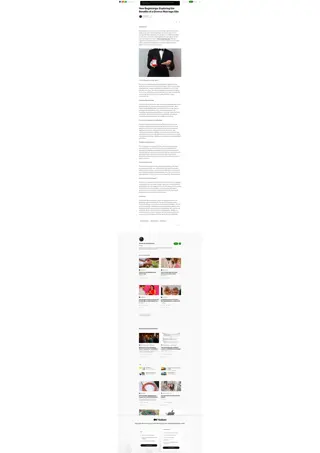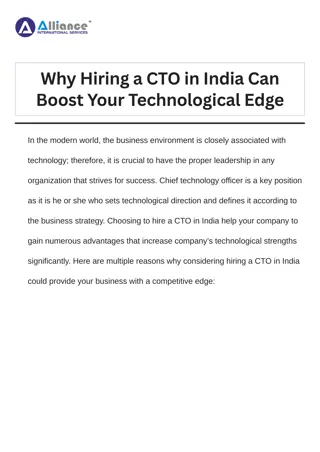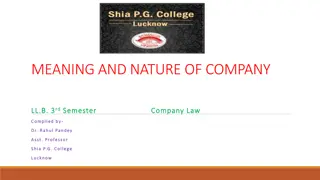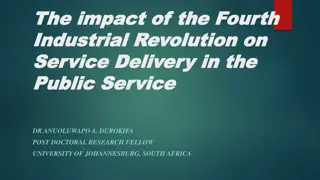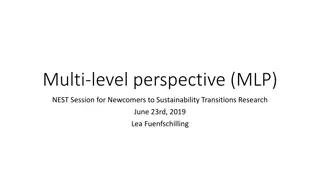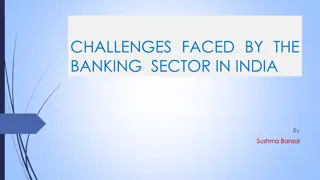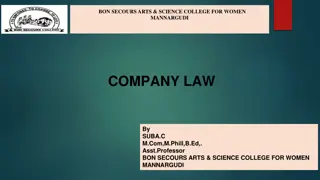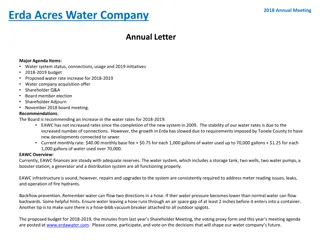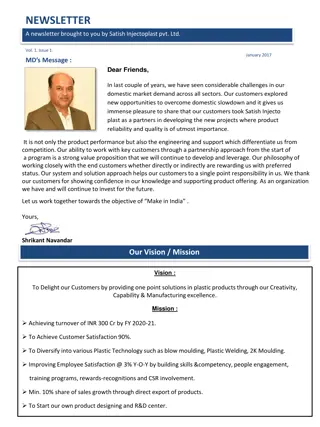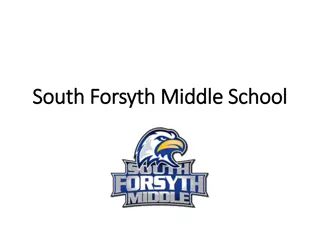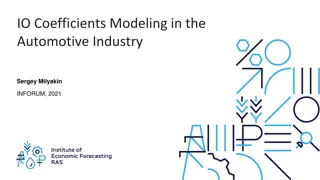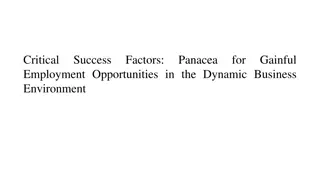Navigating Technological Changes for Company Success
Embrace the psychology of change to manage technological advancements effectively. From entry-level innovations like drones to advanced solutions like AI, discover how incremental progress fosters confidence and success in the evolving business landscape. Stakeholder engagement and ownership play a pivotal role in driving transformation projects towards a 70% success rate.
Download Presentation

Please find below an Image/Link to download the presentation.
The content on the website is provided AS IS for your information and personal use only. It may not be sold, licensed, or shared on other websites without obtaining consent from the author.If you encounter any issues during the download, it is possible that the publisher has removed the file from their server.
You are allowed to download the files provided on this website for personal or commercial use, subject to the condition that they are used lawfully. All files are the property of their respective owners.
The content on the website is provided AS IS for your information and personal use only. It may not be sold, licensed, or shared on other websites without obtaining consent from the author.
E N D
Presentation Transcript
Angus McLeod WHIN Education Consultant, VP of Coaching at AMA
AGILE Managing of Change Dr Angus McLeod Most people are afraid of change, but if you look at it like it s something you can count on, then it can be a comfort. [Robert Kincaid (Clint Eastwood), in The Bridges of Madison County , Warner Bros, 1995].
Things are Moving Faster The average lifespan of a company listed in the S&P 500 index of leading US companies has decreased from 67 years in the 1920s to just 15 years in 2014 . The prediction for 2020 S&P survival time is just 12 years. Ref: Professor Richard Foster at Yale University, reported in: Can a company live forever? Kim Gittleson, 19 January 2012., BBC News, New York.
Change: Do it bit-by-bit Monumental failure is avoided All stake-holders gain confidence, one step at a time Success & confidence further encourages technological advance.
Technological Changes 1 Entry-level technological innovation may include: Drones 3D printing Paper-to-digital Virtual Reality (e.g. for training) and Augmented Reality (e.g. as an efficient aid for assembly workers) & Holo-lens (wide-angle + info).
Technological Changes 2 Intermediate-level technological innovation may include: ERP CRP PLM Digital-double technology Robotics/automation Digital-modelling Sensors and intelligent data-use for manufacturing efficacy and machine-learning. ERP = Enterprise Resource Planning. CRP = Capacity Requirements Planning. PLM = Product Life-cycle Management.
Technological Changes 3 Advanced-level technological innovation may include: Big-data Artificial Intelligence Integrated IT-OT Convergence Full IoT Block-chain. IT-OT Convergence = Information Technology & Operational Technology Convergence.
Stakeholders & Ownership When leaders ensure that front-line staff members feel a sense of ownership: transformation projects achieve a 70% success, compared with the often-quoted statistic that only 30% of transformation projects succeed. Bottom-up knowledge, skills and experience give better solutions & more options for change, than the old top-down approach Change is smoother & faster with wide-ranging buy-in and ownership by stakeholders at all levels Create a Change-Team of change agents from ALL levels and imply equal status. Ref: McKinsey: What successful transformations share, March 2010 Survey.
Leveraging Ownership Healthy communication: Wide sharing of (relevant) automated data Improved quality of feedback with real-time coaching Linking project tasks & reviews to actual goals Shared and individual goal-based system, perhaps using an automated performance management platform, and Make goals SMART, or better, to leverage all the talent, SMARTIE. SMARTIE = Specific. Measurable, Attainable, Relevant, Time-based and, Inclusion & Equity.
Support Change: Smart People & Business 1 Leverage ownership with healthy communication: Technical skills training & certification Problem-solving skills training Visual-stream mapping mastery for supervisors and managers Culture-wide coaching skills for supervisors and managers 1-2-1 professional coaching for the top team Adopt a healthy feedback methodology as a work-place practice Acknowledgement & Reward Scheme for beneficial change delivery (safety, quality and financial).
Support Change: Smart People & Business 2 Merit-based promotion 5s, ISO9000 and attaining/maintaining a high safety culture Underpinning the freedom to comment and feedback, respectfully, on below-ideal practices beyond every worker s remit & responsibility Uptick in the quality of the fabric and environment of the work-place, including locker-areas, toilet facilities and canteen areas Involvement in the community and involvement of worker s families, especially in activities and at acknowledgement & reward-giving events for staff.
Be Skilled in Development Areas 1 Focus on lesser-strengths first
Be Skilled in Development Areas SMART People Shop-floor people skills: versatility, accountability, applied knowledge Management agility: Agile, Disruptive Business Modeling SMART Business Shop-floor systemization: safety, 5s, QA SMART Technology From drones to IoT & block-chain.
Communication Strategies: Key to all Change Use questioning-style and listen Themed and consistent messaging Team-meetings Town Halls Support structures for issues What is familiar is no longer scary.
AGILE Managing of Change 1 Dr Angus McLeod Most people are afraid of change, but if you look at it like it s something you can count on, then it can be a comfort. [Robert Kincaid (Clint Eastwood), in The Bridges of Madison County , Warner Bros, 1995].
Listening & questioning Use Reflective Language show you heard Use questions to increase self-managing & to improve focus on continuous improvement Use questions to create responsibility When they suffer, use silence to prolong the pain.
Coaching Skills Assume they are brighter than you think Ask them what they need from you to perform Ask questions; do not give direction unless vital If they do not understand, contextualize, give examples Make accountable for actions and follow-up.
Feedback & Praise Habitualize praise, so giving feedback is easy Set expectations for praising events per shift Give contextualized developmental feedback. When XYZ happened on line B six minutes ago, we lost 7 units, if there was one thing that you could have done better, what is that one thing? This format uses our knowledge of neural pathways and McLeod s Reflective Language to produce productive solutions from more people, more of the time.
AGILE Managing of Change 2 Dr Angus McLeod Most people are afraid of change, but if you look at it like it s something you can count on, then it can be a comfort. [Robert Kincaid (Clint Eastwood), in The Bridges of Madison County , Warner Bros, 1995].







